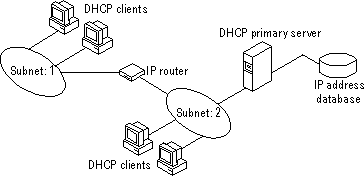
A router is a TCP/IP gateway computer that has two or more network adapter cards (NICs). Each adapter is connected to a different physical network (a subnet). A router device provides services that are determined by the hardware and software configuration of the computer that serves as the router.
Routers that implement the DHCP/BOOTP relay agent as specified by RFC 1542 can be used to route traffic between DHCP servers and clients located on different subnets. The relay agent on the router forwards requests from local DHCP clients to the remote DHCP server and subsequently relays the DHCP server responses back to the DHCP clients. The following figure illustrates an example of a routed network with DHCP server and DHCP clients.

Figure 7.3 An Internetwork Using Automatic TCP/IP Configuration with DHCP
Windows NT Server version 4.0 includes Multi-Protocol Router (MPR), which is a software router that can be configured on a general purpose computer to provide DHCP/BOOTP relay agent support. MPR includes:
Note
Windows NT supports DHCP but does not support BOOTP. You can use Microsoft DHCP server on the same network with clients and servers running BOOTP. The Windows NT-based DHCP servers simply ignore any BOOTP client packets that they may receive from the network. You must make sure, however, that the BOOTP server and the DHCP server do not manage leases for the same IP addresses. The best way to ensure that there is no overlap in managed addresses is to define the scope of the DHCP server as the entire address range that is managed by both the DHCP server and the BOOTP server, and then exclude the address range that is managed by the BOOTP server. As BOOTP clients are dropped or upgraded to DHCP, the exclusion range can be adjusted accordingly.
Additional planning issues for a large enterprise network are:
As one example of planning for a large enterprise network, the segmenting of the WAN into logical subnets could match the physical structure of the internetwork. Then one IP subnet can serve as the backbone, and off this backbone each physical subnet would maintain a separate IP subnet address.
In this case, for each subnet a single computer running Windows NT Server could be configured as both the DHCP and WINS server. Each server would administer a defined number of IP addresses with a specific subnet mask, and would also be defined as the default gateway. Because the server is also acting as the WINS server, it can respond to name resolution requests from all systems on its subnet.
These DHCP and WINS servers can in turn be backup servers for each other. The administrator can partition the address pool for each server to provide addresses to remote clients.
There is no limit to the maximum number of clients that can be served by a single DHCP server. However, your network can have practical constraints based on the IP address class, and server configuration issues such as disk capacity and CPU speed.